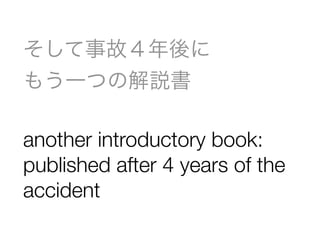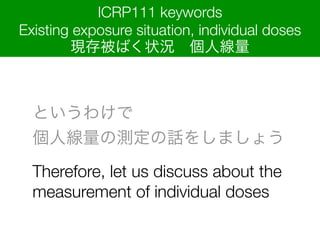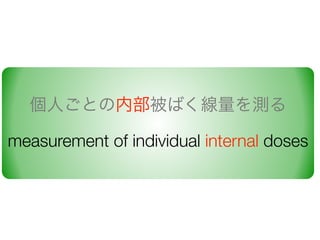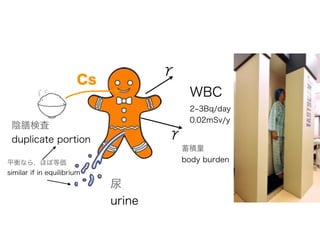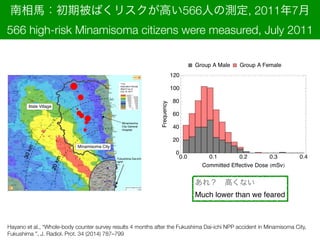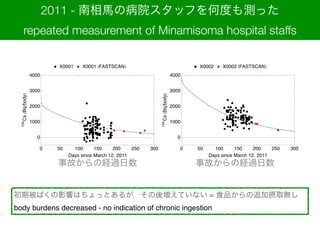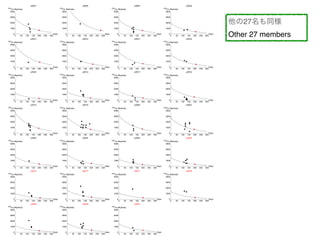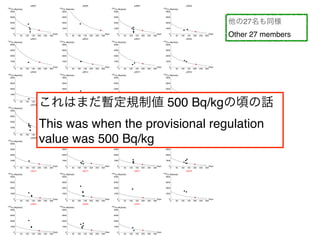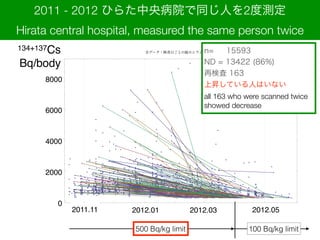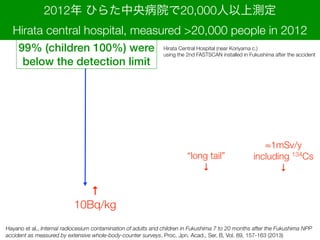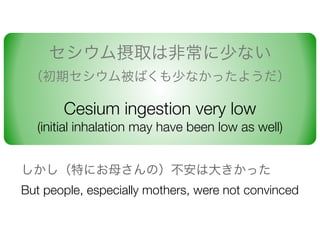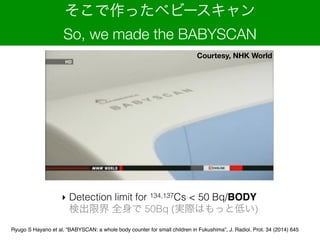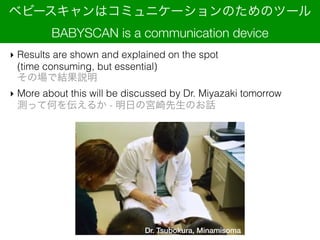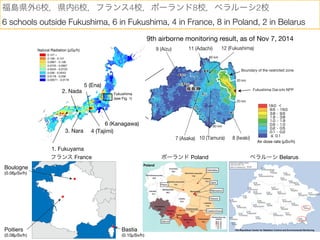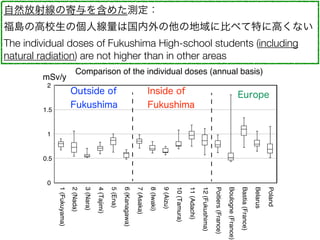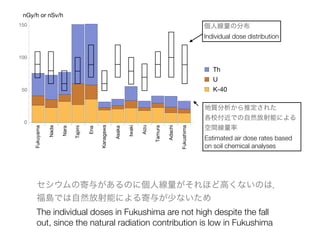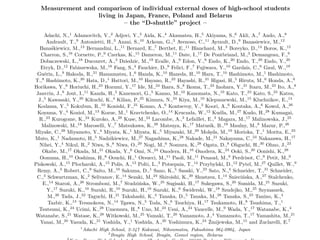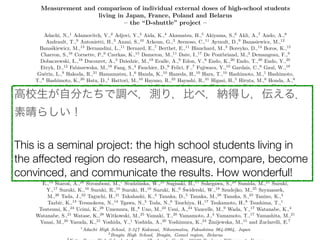ICRP タ?イアロク? 2015.05.30 "Radiation measurements - what, how, and why?"
- 1. hayano Radiation measurements - what, how, and why? いろいろな放射線の測定 ? Ryugo S. Hayano 早野 龍五? ? Physics department, The University of Tokyo May 30, 2015, ICRP 11th dialogue seminar, Fukushima City
- 2. “antimatter” at CERN Team leader since 1997 ジュネーブのCERN研究所で 「反物質」を研究 No past experience in Radiation Protection nor Risk Communication - School lunch measurement - large-scale WBC surveys - BABYSCAN - “D-shuttle” Photo CERN 2011年3月以前に放射線防護 リスクコミュニケーションの経験皆無 - 給食の放射能検査 - WBCによる内部被ばく測定と論文 - BABYSCANの開発?測定?論文 - D-shuttle による外部被ばく測定
- 3. Science Magazine Blog top 100 scientists on twitter October 2014
- 4. European Space Agency 20. Steven Pinker, Cognitive scientist 145,000 followers @sapinker (http://twitter.com/@sapinker) Citations: 49,933 K-index: 105 Total number of tweets: 1,674 Harvard University, United States 21. Richard Wiseman, Psychologist 135,000 followers @RichardWiseman (http://twitter.com/@RichardWiseman) Citations: 4,687 K-index: 209 Total number of tweets: 22,600 University of Hertfordshire, United Kingdom 22. Ryugo Hayano, Nuclear physicist 124,000 followers @hayano (http://twitter.com/@hayano) Citations: 956 K-index: 319 Total number of tweets: 56,500 University of Tokyo, Japan 23. Toshiyuki Masui, Computer scientist 122,000 followers @masui (http://twitter.com/@masui) … …
- 5. 知ろうとすること。 新潮文庫 早 野 龍 五 東 京 大 学 大 学 院 理 学 系 研 究 科 教 授 糸 井 重 里 in stores, Oct 1, 2014, >100,000 copies printed so far, e-book (kindle, etc.), May 1, 2015
- 6. The theme of the 11th dialogue 「測定し、生活を取り戻す」 Measure, and regain control of the lives
- 7. 事故の影響を受けた地域では? 何を,どのように測定することが重要か? そして,それは何のため? In the area affected by the accident, what should we measure, how, and why?
- 10. INTERNATIONAL COMMISSION ON RADIOLOGICAL PROTECTION April 4, 2011 The International Commission on Radiological Protection (ICRP) in cooperation with Elsevier, the publishers of the Annals of the ICRP, present this special cost- free release of ICRP Publication 111 Application of the Commission’s Recommendations to the Protection of People Living in Long-term Contaminated Areas after a Nuclear Accident or a Radiation Emergency. ICRP is a registered charity that relies on the sale of publications to help support its ongoing work. However, the cost-free release of this publication is a gesture to aid the Japanese people in recovering from the recent earthquake, tsunami, and accident at the Fukushima Daiichi nuclear power plant. Our thoughts are with those in Japan dealing with the aftermath of these tragic events, and we regret that the recommendations of ICRP Publication 111 need to be put into active use so soon after having been published. This special free release of ICRP Publication 111 is dedicated to those in Japan who have lost so very much. With deep sympathy, on behalf of ICRP, Claire Cousins ICRP Chair Christopher Clement ICRP Scientific Secretary 英語版無料公開 2011年4月4日
- 11. My tweet on ICRP 111, April 16, 2011 (私のツイートは公開2週間後ぐらいだった) 東大医学部の中川先生から教えていただいた
- 12. EXECUTIVE SUMMARY (a) The present report provides guidance on the application of the Commission’s Recommendations for the protection of people living in long-term contaminated areas resulting from either a nuclear accident or a radiation emergency. This post- accident rehabilitation situation is considered by the Commission as an ‘existing exposure situation’. (b) The following recommendations are the ?rst to deal with the management of existing exposure situations since publication of the 2007 Recommendations (ICRP, 2007). They complement those made in Publication 82 (ICRP, 2000), and further develop the role of stakeholders, introduced for the ?rst time by the Commission in this publication. They also take into account the evolution introduced by the 2007 Recommendations from the previous process-based approach of practices and interventions to an approach based on the characteristics of radiation exposure situations. They particularly emphasise the new approach of the Commission, which reinforces the principle of optimisation of protection to be applied in a similar way to all exposure situations with restrictions on individual doses. (c) Although developed for managing a speci?c category of existing exposure sit- uation, many recommendations developed in this report are broadly applicable with the necessary adaptations to other existing exposure situations like, for example, ra- don in dwellings and workplaces, naturally occurring radioactive material, or con-
- 13. (a) 本報告書は,原子力事故または放射線緊急事態によって生じた長期汚染地域に居住す る人々の防護のための委員会勧告の適用に関するガイダンスを提供するものである。委員会 は,この事故後の復旧状況を“現存被ばく状況”と見なしている。 (b) 以下の勧告は,2007 年勧告(ICRP, 2007)の発行以降,現存被ばく状況の管理につい て取り扱った初めてのものである。これらの勧告は,Publication 82(ICRP, 2000)の勧告を 補完し,委員会が同書で初めて導入した“ステークホルダー”(p.1 脚注参照)の役割を更に 展開させている。これらの勧告はまた,行為と介入というプロセスに基づく以前のアプローチ から,放射線被ばく状況の特性に基づくアプローチへ,という 2007 年勧告によって導入され た発展も考慮している。これらは,個人線量に関する制限によって,すべての被ばく状況に対 し同様の方法で適用できる防護の最適化原則を強化するという,委員会の新たなアプローチを 特に強調している。 (c) 本報告書で策定された多くの勧告は,現存被ばく状況のなかの特定のカテゴリーを管 理するために策定されたものであるが,必要な調整により,例えば,住居内または作業場内の ラドン,自然起源の放射性物質,または過去の原子力活動や産業活動によって汚染された場所 などの他の現存被ばく状況にも幅広く適用可能である。この勧告は,防護戦略を計画するため の参考レベルの使用,当局によって履行される防護対策を補う自助努力による防護対策の役 割,および被災した人々に情報を知らせるための付随手段に,特に関係している。 (d) 緊急時被ばく状況から現存被ばく状況への移行は,潜在的に高いレベルの被ばくおよ 和訳公開 May 2012
- 16. twitterが媒介して? ブレークスルーがもたらされた twitter mediated a breakthrough
- 17. Introduction to ICRP Publ. 111 先生 J_Tphoto buvery 生徒会長 [国際放射線防護委員会 ICRP入門講座 対話篇] × ◎じゃあ、それはどうやったら可能になるの? ?──オープンな議論、利害の調整、福島との連帯。 ?──リスクを引き受ける人が判断する。慎重に、理性的に。 ◎放射線の被曝って、どこまで下げれば十分なの? ◎住みつづけたい人で、もっとも線量の高い人から ?被曝を減らすようにする、ってなに? ◎社会的?経済的な要素を考えに入れて、 ?合理的に、達成できる限り低くする、ってなに? ICRP111から 考えたこと 福島で「現存被曝状況」を生きる Introduction to ICRP Publ. 111 Made on Twitter 2012.02.09 2012.03.04 by @J_Tphoto & @buvery Published on ? March 28, 2012 ? as a free ebook 2012年の2-3月にTwitterで? @J_Tphoto & @buvery ? 「勉強会」 2012年3月28日より無償配布 ネットからダウンロード可能 (ICRP111の和訳が出る前)
- 18. そして事故4年後に? もう一つの解説書 another introductory book: published after 4 years of the accident
- 19. not free, ? some copies available today 無償ではありませんが 本日会場に何部か置いて あります Niwa, Kai, Kanda, Hayano, Homma, Miyazaki, Sakoda 丹羽,甲斐,神田,早野,本間,宮崎,迫田
- 20. というわけで? 個人線量の測定の話をしましょう Therefore, let us discuss about the measurement of individual doses ICRP111 keywords Existing exposure situation, individual doses 現存被ばく状況?個人線量
- 21. 1. (内部+外部)個人の積算線量が? リスクに比例 2. 個人ごとに違う(同地域,同家庭でも)? ロングテールがある 3. 測定で自由を取り戻す? (明日の宮崎先生のお話) なぜ個人線量? Why individual doses? 1. (internal+external) cumulative dose: proportional to the risk 2. Doses differ from person to person (long tail) 3. Measurement → freedom? (Dr. Miyazaki’s talk, tomorrow) ← longtail 人 数 個人線量レベル 参考レベル 時 ? 間 人 数 個人線量レベル 参考レベル 人 数 個人線量レベル 参考レベル した結果に基づくべきである。参考レベルの値を選定するプロセスもまた,関係するすべての ステークホルダーの見解を適切に取り入れるために注意深くバランスをとるべきである。 (50) 現存被ばく状況にとっての長期目標は,“被ばくを通常と考えられるレベルに近いか あるいは同等のレベルまで引き下げること”(ICRP, 2007,288 項)であることから,汚染地域 内に居住する人々の防護の最適化のための参考レベルは,このカテゴリーの被ばく状況の管理 のために Publication 103(ICRP, 2007)で勧 告された 1~20 mSv のバンドの下方部分か ら選択すべきであることを,委員会は勧告す る。過去の経験は,長期の事故後の状況にお ける最適化プロセスを拘束するために用いら れる代表的な値が 1 mSv/年であることを示 している(付属書 A を参照)。国の当局は, その時点で広く見られる状況を考慮に入れ, また,復旧プログラム全体のタイミングを利 用して,状況を徐々に改善するために中間的 な参考レベルを採用してもよい。 (51) 参考レベルは,防護戦略を計画す る場合には(また,例えば食品の取引のよう なある特別な防護対策の履行に対して,必要 に応じて誘導参考レベルを決める場合には) 予測的に用いられ,また履行された防護戦略 の有効性を判断するためのベンチマークとし て遡及的にも用いられる。防護対策の主要な 焦点は,参考レベルを上まわる被ばくに向け られるべきであり,そのような被ばくがある ことは被ばくの分布が均一ではないことを示 唆している可能性がある。このような場合に は住民全体の防護よりもむしろ最も高く被ば ICRP111
- 22. 個人ごとの内部被ばく線量を測る measurement of individual internal doses
- 23. Cs γ γ 陰膳検査 duplicate portion 尿 urine 平衡なら,ほぼ等価 similar if in equilibrium 蓄積量 body burden WBC 2 3Bq/day 0.02mSv/y
- 24. 134 Cs Deposition Density (Bq/m2 ) as of July 16, 2011 20km 30km Fukushima Dai-ichi NPP Minamisoma City General Hospital Minamisoma City Iitate Village 南相馬:初期被ばくリスクが高い566人の測定, 2011年7月 566 high-risk Minamisoma citizens were measured, July 2011 Group A Male Group A Female 0.0 0.1 0.2 0.3 0.4 0 20 40 60 80 100 120 Committed Effective Dose HmSvLFrequency あれ??高くない Much lower than we feared Hayano et al., “Whole-body counter survey results 4 months after the Fukushima Dai-ichi NPP accident in Minamisoma City, Fukushima ”, J. Radiol. Prot. 34 (2014) 787–799
- 25. 2011 - 南相馬の病院スタッフを何度も測った repeated measurement of Minamisoma hospital staffs X0001 X0001 HFASTSCANL 0 50 100 150 200 250 300 0 1000 2000 3000 4000 Days since March 12, 2011 134 CsHBqêbodyL X0002 X0002 HFASTSCANL 0 50 100 150 200 250 300 0 1000 2000 3000 4000 Days since March 12, 2011 134 CsHBqêbodyL事故からの経過日数 事故からの経過日数 初期被ばくの影響はちょっとあるが,その後増えていない = 食品からの追加摂取無し body burdens decreased - no indication of chronic ingestion
- 26. 0 50 100 150 200 250 300 Days0 1000 2000 3000 4000 134Cs HBqêbodyL x0007 0 50 100 150 200 250 300 Days0 1000 2000 3000 4000 134Cs HBqêbodyL x0008 0 50 100 150 200 250 300 Days0 1000 2000 3000 4000 134Cs HBqêbodyL x0009 0 50 100 150 200 250 300 Days0 1000 2000 3000 4000 134Cs HBqêbodyL x0040 0 50 100 150 200 250 300 Days0 1000 2000 3000 4000 134Cs HBqêbodyL x0042 0 50 100 150 200 250 300 Days0 1000 2000 3000 4000 134Cs HBqêbodyL x0044 0 50 100 150 200 250 300 Days0 1000 2000 3000 4000 134Cs HBqêbodyL x0045 0 50 100 150 200 250 300 Days0 1000 2000 3000 4000 134Cs HBqêbodyL x0046 0 50 100 150 200 250 300 Days0 1000 2000 3000 4000 134Cs HBqêbodyL x0048 0 50 100 150 200 250 300 Days0 1000 2000 3000 4000 134Cs HBqêbodyL x0054 0 50 100 150 200 250 300 Days0 1000 2000 3000 4000 134Cs HBqêbodyL x0055 0 50 100 150 200 250 300 Days0 1000 2000 3000 4000 134Cs HBqêbodyL x0056 0 50 100 150 200 250 300 Days0 1000 2000 3000 4000 134Cs HBqêbodyL x0076 0 50 100 150 200 250 300 Days0 1000 2000 3000 4000 134Cs HBqêbodyL x0079 0 50 100 150 200 250 300 Days0 1000 2000 3000 4000 134Cs HBqêbodyL x0080 0 50 100 150 200 250 300 Days0 1000 2000 3000 4000 134Cs HBqêbodyL x0082 0 50 100 150 200 250 300 Days0 1000 2000 3000 4000 134Cs HBqêbodyL x0089 0 50 100 150 200 250 300 Days0 1000 2000 3000 4000 134Cs HBqêbodyL x0096 0 50 100 150 200 250 300 Days0 1000 2000 3000 4000 134Cs HBqêbodyL x0098 0 50 100 150 200 250 300 Days0 1000 2000 3000 4000 134Cs HBqêbodyL x0028 0 50 100 150 200 250 300 Days0 1000 2000 3000 4000 134Cs HBqêbodyL x0043 0 50 100 150 200 250 300 Days0 1000 2000 3000 4000 134Cs HBqêbodyL x0053 0 50 100 150 200 250 300 Days0 1000 2000 3000 4000 134Cs HBqêbodyL x0057 0 50 100 150 200 250 300 Days0 1000 2000 3000 4000 134Cs HBqêbodyL x0058 0 50 100 150 200 250 300 Days0 1000 2000 3000 4000 134Cs HBqêbodyL x0060 0 50 100 150 200 250 300 Days0 1000 2000 3000 4000 134Cs HBqêbodyL x0069 0 50 100 150 200 250 300 Days0 1000 2000 3000 4000 134Cs HBqêbodyL x0093 他の27名も同様 Other 27 members
- 27. 0 50 100 150 200 250 300 Days0 1000 2000 3000 4000 134Cs HBqêbodyL x0007 0 50 100 150 200 250 300 Days0 1000 2000 3000 4000 134Cs HBqêbodyL x0008 0 50 100 150 200 250 300 Days0 1000 2000 3000 4000 134Cs HBqêbodyL x0009 0 50 100 150 200 250 300 Days0 1000 2000 3000 4000 134Cs HBqêbodyL x0040 0 50 100 150 200 250 300 Days0 1000 2000 3000 4000 134Cs HBqêbodyL x0042 0 50 100 150 200 250 300 Days0 1000 2000 3000 4000 134Cs HBqêbodyL x0044 0 50 100 150 200 250 300 Days0 1000 2000 3000 4000 134Cs HBqêbodyL x0045 0 50 100 150 200 250 300 Days0 1000 2000 3000 4000 134Cs HBqêbodyL x0046 0 50 100 150 200 250 300 Days0 1000 2000 3000 4000 134Cs HBqêbodyL x0048 0 50 100 150 200 250 300 Days0 1000 2000 3000 4000 134Cs HBqêbodyL x0054 0 50 100 150 200 250 300 Days0 1000 2000 3000 4000 134Cs HBqêbodyL x0055 0 50 100 150 200 250 300 Days0 1000 2000 3000 4000 134Cs HBqêbodyL x0056 0 50 100 150 200 250 300 Days0 1000 2000 3000 4000 134Cs HBqêbodyL x0076 0 50 100 150 200 250 300 Days0 1000 2000 3000 4000 134Cs HBqêbodyL x0079 0 50 100 150 200 250 300 Days0 1000 2000 3000 4000 134Cs HBqêbodyL x0080 0 50 100 150 200 250 300 Days0 1000 2000 3000 4000 134Cs HBqêbodyL x0082 0 50 100 150 200 250 300 Days0 1000 2000 3000 4000 134Cs HBqêbodyL x0089 0 50 100 150 200 250 300 Days0 1000 2000 3000 4000 134Cs HBqêbodyL x0096 0 50 100 150 200 250 300 Days0 1000 2000 3000 4000 134Cs HBqêbodyL x0098 0 50 100 150 200 250 300 Days0 1000 2000 3000 4000 134Cs HBqêbodyL x0028 0 50 100 150 200 250 300 Days0 1000 2000 3000 4000 134Cs HBqêbodyL x0043 0 50 100 150 200 250 300 Days0 1000 2000 3000 4000 134Cs HBqêbodyL x0053 0 50 100 150 200 250 300 Days0 1000 2000 3000 4000 134Cs HBqêbodyL x0057 0 50 100 150 200 250 300 Days0 1000 2000 3000 4000 134Cs HBqêbodyL x0058 0 50 100 150 200 250 300 Days0 1000 2000 3000 4000 134Cs HBqêbodyL x0060 0 50 100 150 200 250 300 Days0 1000 2000 3000 4000 134Cs HBqêbodyL x0069 0 50 100 150 200 250 300 Days0 1000 2000 3000 4000 134Cs HBqêbodyL x0093 他の27名も同様 Other 27 members これはまだ暫定規制値 500 Bq/kgの頃の話 This was when the provisional regulation value was 500 Bq/kg
- 28. Nov Jan Mar May 0 2000 4000 6000 8000 全データ:検査日ごとの総セシウム Bqêbodyn= 15593 ND = 13422 (86%) 再検査 163 ? 上昇している人はいない all 163 who were scanned twice showed decrease 8000 6000 4000 2000 0 134+137Cs Bq/body 2011.11 2012.01 2012.03 2012.05 2011 - 2012 ひらた中央病院で同じ人を2度測定 Hirata central hospital, measured the same person twice 100 Bq/kg limit500 Bq/kg limit
- 29. 2012年 ひらた中央病院で20,000人以上測定 Hirata central hospital, measured >20,000 people in 2012 L 50 200 12 n=21785, nnd=21573 H99.0 %L 0 50 100 150 200 0 10 20 30 40 137 Cs concentration HBqêkgL Frequency All subjects: Mar 2012-Nov 2012 2012 10 Children Hage?15L: Mar 2012-Nov 2012 ↑ 10Bq/kg ≈1mSv/y? including 134Cs ↓ 99% (children 100%) were below the detection limit “long tail” ↓ Hirata Central Hospital (near Koriyama c.) using the 2nd FASTSCAN installed in Fukushima after the accident Hayano et al., Internal radiocesium contamination of adults and children in Fukushima 7 to 20 months after the Fukushima NPP accident as measured by extensive whole-body-counter surveys, Proc. Jpn. Acad., Ser. B, Vol. 89, 157-163 (2013)
- 30. セシウム摂取は非常に少ない (初期セシウム被ばくも少なかったようだ) Cesium ingestion very low? (initial inhalation may have been low as well) しかし(特にお母さんの)不安は大きかった But people, especially mothers, were not convinced
- 31. Courtesy, NHK World そこで作ったベビースキャン So, we made the BABYSCAN ? Detection limit for 134,137Cs < 50 Bq/BODY? 検出限界 全身で 50Bq (実際はもっと低い) Ryugo?S Hayano et al, “BABYSCAN: a whole body counter for small children in Fukushima”, J. Radiol. Prot. 34 (2014) 645
- 32. 四年連続して行った三春町児童生徒の内部被ばく検査? WBC surveys of Miharu-town school children for four consecutive years Hayano et al., “Whole body counter surveys of Miharu-town school children for four consecutive years after the Fukushima NPP accident”, Proc. Japan Acad., Ser. B91 (2015) 92-98. 8 Well water 21 % Tap water 55 % Bottled water 23 % Other 2 % 0 20 40 60 80 100 Homeêlocal rice 62 % Buy Fukushima 2 % Buy any rice 20 % Avoid Fukushima rice 13 % Other 3 % 0 20 40 60 80 100 Eat local, untested produce 11 % Homeêlocal produce 16 % Buy Fukushima 2 % Buy any produce 49 % Avoid Fukushima produce 16 % Other 6 % 0 20 40 60 80 100 Water Rice Vegetable FIG. 9: Graph showing results of questionnaire concerning water, rice, and vegetable consumption of Miharu 2014年秋,小中学校低学年はBABYSCANを使用?しかし一人も検出されない 多くの家庭では、水道水?井戸水を飲み、福島産の米や野菜を忌避していない Nobody had detectable level of cesium, even with the BABYSCAN? Questionnaire show that most of them are consuming local/home-grown foodstuff 水道水を避け ペットボトルの水を飲む only drink bottled water 福島県産の農産物は? 食べない avoid Fukushima produce 水 米 野菜
- 33. ? Results are shown and explained on the spot ? (time consuming, but essential)? その場で結果説明 ? More about this will be discussed by Dr. Miyazaki tomorrow? 測って何を伝えるか - 明日の宮崎先生のお話 ベビースキャンはコミュニケーションのためのツール? BABYSCAN is a communication device Dr. Tsubokura, Minamisoma
- 34. 個人ごとの外部被ばく線量を測る measurement of individual external doses 午後に福島高校の生徒さんによる画期的な発表 Stay tuned for the presentation by the Fukushima high-school students this afternoon
- 35. 四カ国216人の高校生がD-シャトルを2週間着けた結果を論文に “D-shuttle” project - 216 high school students from 4 countries wore D-shuttle for 2 weeks, and write a paper D-シャトルは1時間ごとの積算線量を記録? - 自然放射線の寄与を含む -? D-shuttle records hourly individual doses? - including natural radiation contribution - 同じ線量計,同じ装着方法と行動記録 Same personal dosimeter, standardized protocol and activity journal
- 36. The Republican Center for Radiation Control and Environmental Monitoring ベラルーシ Belarusポーランド Poland Poitiers (0.08?Sv/h) Boulogne (0.06?Sv/h) Bastia (0.10?Sv/h) フランス France Ostroleka Plock Zabrze Czestochowa Otwock Warszawa Zabki Poland 9th airborne monitoring result, as of Nov 7, 2014 Air dose rate (?Sv/h) Japan Fukushima Prefecture Fukushima Dai-ichi NPP 20 km 20 km Boundary of the restricted zone 12 (Fukushima) 7 (Asaka) 8 (Iwaki) 9 (Aizu) 10 (Tamura) 11 (Adachi) 80 km 80 km 6 (Kanagawa) 5 (Ena) 4 (Tajimi)3. Nara 2. Nada 1. Fukuyama Fukushima (see Fig. 1) Natural Radiation (?Gy/h) 0.127 < 0.109 - 0.127 0.0907 - 0.109 0.0725 - 0.0907 0.0543 - 0.0725 0.036 - 0.0543 0.0178 - 0.036 0.00571 - 0.0178 福島県外6校,県内6校,フランス4校,ポーランド8校,ベラルーシ2校 6 schools outside Fukushima, 6 in Fukushima, 4 in France, 8 in Poland, 2 in Belarus
- 37. 自然放射線の寄与を含めた測定:? 福島の高校生の個人線量は国内外の他の地域に比べて特に高くない The individual doses of Fukushima High-school students (including natural radiation) are not higher than in other areas 0 0.5 1 1.5 2 1(Fukuyama) 2(Nada) 3(Nara) 4(Tajimi) 5(Ena) 6(Kanagawa) 7(Asaka) 8(Iwaki) 9(Aizu) 10(Tamura) 11(Adachi) 12(Fukushima) Poitiers(France) Boulogne(France) Bastia(France) Belarus Poland mSv/y Outside of Fukushima EuropeInside of Fukushima Comparison of the individual doses (annual basis) Inside of Fukushima EuropeOutside of Fukushima
- 38. セシウムの寄与があるのに個人線量がそれほど高くないのは, 福島では自然放射能による寄与が少ないため The individual doses in Fukushima are not high despite the fall out, since the natural radiation contribution is low in Fukushima Fukuyama Nada Nara Tajimi Ena Kanagawa Asaka Iwaki Aizu Tamura Adachi Fukushima 0 50 100 150 Th U K-40 nGy/h or nSv/h 個人線量の分布 Individual dose distribution 地質分析から推定された 各校付近での自然放射能による 空間線量率 Estimated air dose rates based on soil chemical analyses
- 40. 高校生が自分たちで調べ,測り,比べ,納得し,伝える. 素晴らしい!? This is a seminal project: the high school students living in the affected region do research, measure, compare, become convinced, and communicate the results. How wonderful!

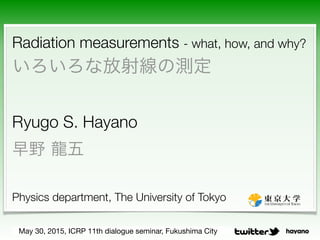




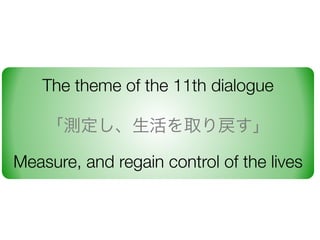
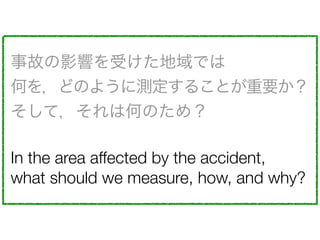
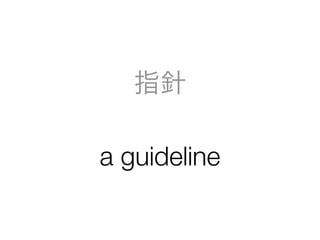
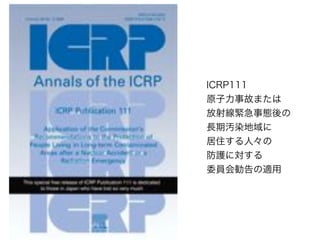
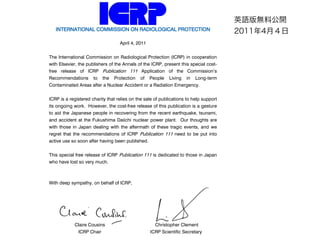


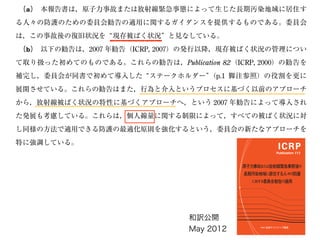



![Introduction to
ICRP Publ. 111
先生
J_Tphoto buvery
生徒会長
[国際放射線防護委員会
ICRP入門講座 対話篇]
×
◎じゃあ、それはどうやったら可能になるの?
?──オープンな議論、利害の調整、福島との連帯。
?──リスクを引き受ける人が判断する。慎重に、理性的に。
◎放射線の被曝って、どこまで下げれば十分なの?
◎住みつづけたい人で、もっとも線量の高い人から
?被曝を減らすようにする、ってなに?
◎社会的?経済的な要素を考えに入れて、
?合理的に、達成できる限り低くする、ってなに?
ICRP111から
考えたこと
福島で「現存被曝状況」を生きる
Introduction to ICRP Publ. 111
Made on Twitter
2012.02.09 2012.03.04
by @J_Tphoto & @buvery
Published on ?
March 28, 2012 ?
as a free ebook
2012年の2-3月にTwitterで?
@J_Tphoto & @buvery ?
「勉強会」
2012年3月28日より無償配布
ネットからダウンロード可能
(ICRP111の和訳が出る前)](https://image.slidesharecdn.com/2015-150530005823-lva1-app6891/85/ICRP-2015-05-30-Radiation-measurements-what-how-and-why-17-320.jpg)
